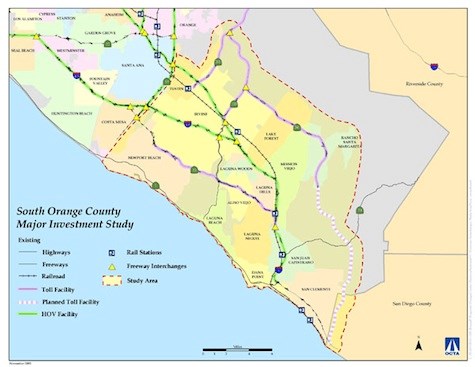South Orange County Major Investment Study
Why a Study?
The ability to efficiently move people, goods and services is critical for the sustained economic growth and quality of life in Orange County. Due to rapid growth in both residential development and employment, south Orange County residents are finding it increasingly difficult to avoid traffic congestion. Interstate 5 (I-5) is the main transportation corridor in the South County area. It is an eight-lane highway with traffic volumes as high as 350,000 vehicle trips per day. Without a long-term strategic vision, the I-5 corridor and surrounding transportation infrastructure will continue to experience increasing levels of congestion.What are the Study Objectives?
The Study Objectives (Purpose and Need) are developed based on feedback received from elected officials and technical staff from agencies and cities, as well as from stakeholders in the study area. These objectives are critical in making sure that the SOC MIS provides solutions for transportation issues for which all parties are in agreement.
Based on input from the cities in the study area, the following study objectives were developed:
- Reduce freeway congestion in the study area
- Minimize freeway travel times
- Provide continuity of facilities and capacity (lane balance)along south Orange County freeways
- Improve freeway access at the interchanges
- Evaluate public transit options
What is the Study Area?
The South Orange County Major Investment Study will assess various alternatives for improving north-south travel from State Route 55 to the Orange/San Diego County border and east-west travel from the foothills to the coast.
What is the Study Schedule?
The study began in early 2006 and is expected to be complete in mid-2008.
Background
Who Provides Guidance for the Study?
The OCTA Board of Directors ultimately sets policy, but will seek input from the study's Policy Advisory Committee, Technical Advisory Committee, and Stakeholder Working Group.Policy Advisory Committee (PAC)
The Policy Advisory Committee was formed to keep elected officials within the project area informed about the progress of the study and seek their input on policy direction to help guide the study process. The 21-member Policy Advisory Committee consistsof 18 voting members representing each city and supervisorial district in the study area, as well as the chair and public member from the OCTA Board of Directors; and three nonvoting members, representing the San Diego Association of Governments (SANDAG),Caltrans, and Transportation Corridor Agencies (TCA).Technical Advisory Committee (TAC)
Each city within the study area, as well as the County of Orange, Caltrans, TCA, FHWA, and SANDAG has a designated staff member to serve on the Technical Advisory Committee. The TAC provides the study team with detailed technical analysis and feedback on every element of the study.Stakeholder Working Group (SWG)
The Stakeholder Working Group provides feedback throughout the study process. Each SWG member represents a constituency and is charged with helping to build consensus for regional transportation solutions. SWG members represent a broad range of interest groups, including: business, environmental, public safety, developers, homeowner associations, transportation, community, etc.